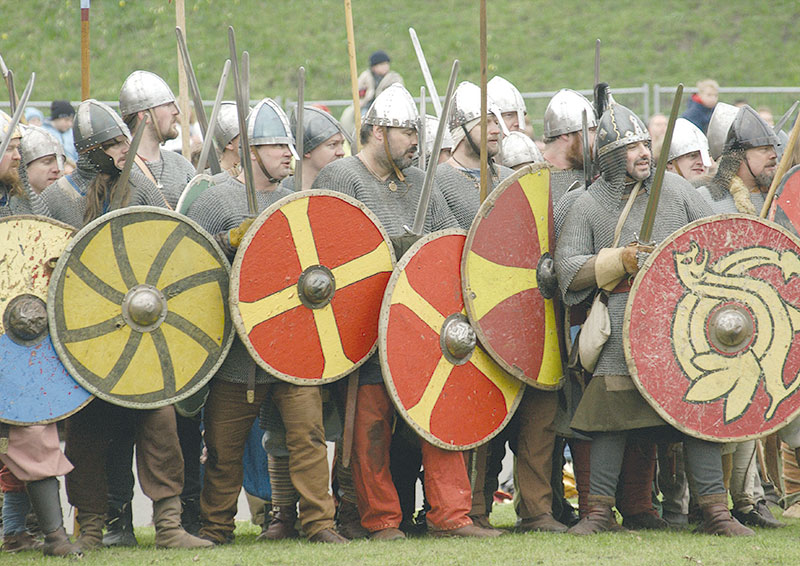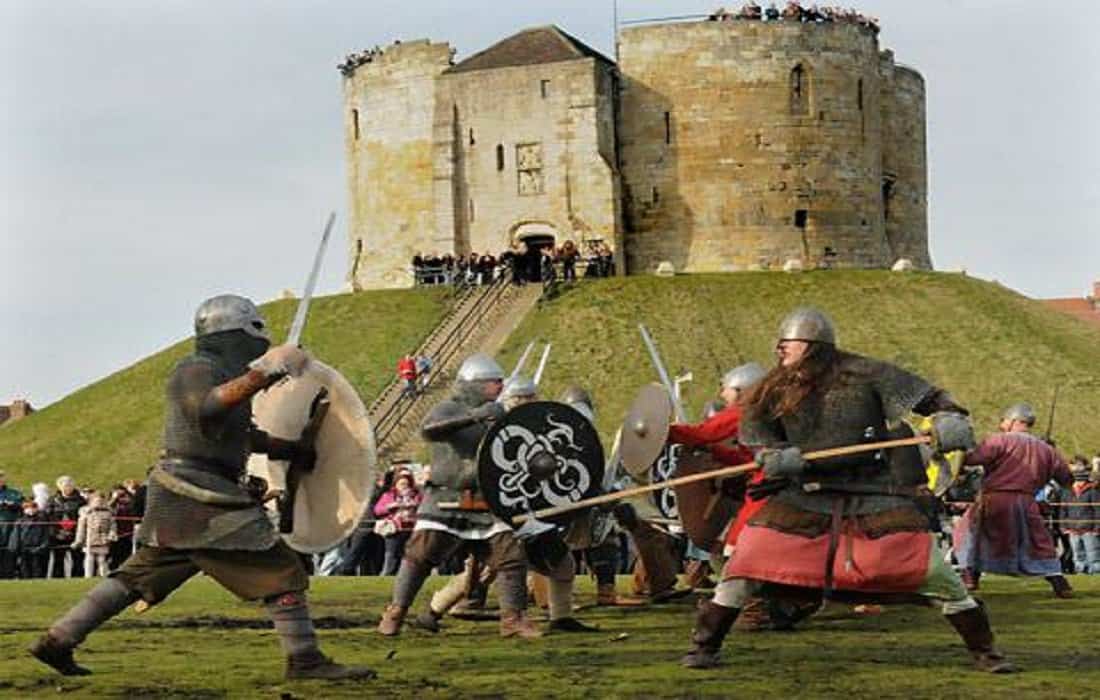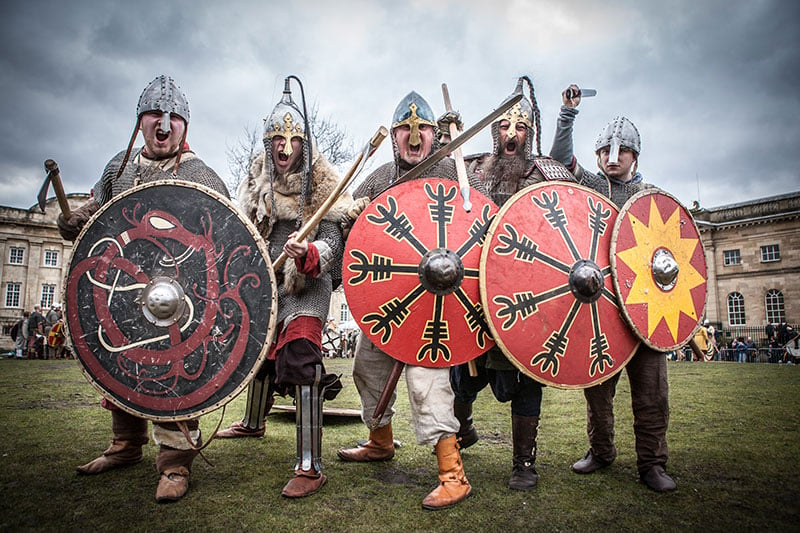Keep Exploring
York, United Kingdom
Essential York
Explore More
TThe city of York, with its cobbled streets, towering cathedrals, and medieval charm, has a rich and diverse history that spans centuries. Its name has undergone several transformations, each reflecting the influence of the cultures that once inhabited this ancient city. Let us take a captivating journey through time to explore York’s Viking history and the legacy they left behind.
Origins of the Name:
The story of York’s name begins with the Romans, who founded the city in AD 71. They called it “Eboracum,” derived from the Celtic word, meaning “Place of Yew Trees.” The Romans recognized the strategic significance of the city’s location at the junction of the Ouse and Foss rivers, and they built strong fortifications to protect it from the surrounding marshy regions.
 Enter the Angles:
Enter the Angles:
After the Romans departed, the Angles, a Germanic tribe, settled in the region. They mistakenly mispronounced “Eboracum” as “Eoforwic,” meaning “Boar Village,” owing to their own language and cultural influences. The Angles embraced the city as their own and added their unique touch to its development.
The Vikings Arrive:
In the 9th century, the Vikings, renowned seafarers from Scandinavia, set their sights on England’s shores. In 865, the infamous Viking leader Ivar the Boneless, along with his brothers, launched a large-scale invasion and captured York in 866. With their arrival came advanced shipbuilding techniques and seafaring knowledge, which significantly boosted York’s status as a commercial hub. The city’s access to the North Sea via the Ouse and Humber rivers opened up lucrative trading opportunities for the Vikings.
 From Jorvik to York:
From Jorvik to York:
The Vikings, with their distinct accent, referred to the city as “Jorvik,” a variation of the name that has since become synonymous with their presence in York. The Viking influence on the city was substantial, leaving a lasting impact on its architecture, customs, and culture.
A Thriving Trading Center:
Despite the Viking invasions and intermittent threats, York continued to flourish as a vital trading port during the Norman period. By the 14th century, it had become England’s second-richest city, driven by a thriving wool and grain trade. York’s merchants exported these goods to Northern Europe while importing exotic fruits from Spain.
The Black Death’s Dark Shadow:
York’s prosperity was not without its challenges. The devastating Black Death, which reached the city in 1349, was partly introduced by trading ships on the Humber. The outbreak quickly decimated York’s population and led to a decline in its wealth and influence. This domino effect led to social and economic disruption, changes in social structures and cultural practices. and religious consequences.
The city, like others affected by the pandemic, faced significant challenges in the aftermath of the crisis, but it ultimately endured and rebuilt itself in the centuries that followed.
York’s Viking history is an integral part of its identity, leaving an indelible mark on the city’s landscape and heritage. From its Roman origins as “Eboracum” to the Viking-era “Jorvik,” the city’s name has evolved alongside the changing tides of history. Despite these changes, York remained an important city, particularly in the fields of education, tourism, and heritage.
Today, York stands as a living testament to the resilience of its people and the vibrant tapestry of cultures that have shaped this captivating city throughout the ages. As you walk through the narrow streets and explore its historic sites, remember that beneath the modern facade lies a city with a captivating past, waiting to be discovered and cherished. Its rich history, medieval architecture, and cultural attractions continue to draw visitors from around the world. While it may not have the same level of economic or political influence as it did in medieval times, York remains a vibrant and historically significant city in the United Kingdom.
FAQs – York’s Viking History: Unraveling the Origins of Jorvik
What is Jorvik, and how does it relate to York?
Jorvik was the name given to York during the Viking period when Norse settlers took control of the city in 866 AD. The name derives from the Old Norse word Jórvík, which became the Viking stronghold and trading center in Northern England. The Viking occupation had a profound and lasting impact on York’s culture, economy, and society.
How did the Vikings come to control York?
In 866 AD, a Viking army known as the Great Heathen Army captured York after a surprise assault. York’s strategic location and thriving trade routes made it an attractive target for Viking settlers, and after its capture, it was transformed into a powerful Viking kingdom that became the capital of the Danelaw—the area of England under Viking rule.
What was life like in Jorvik under Viking rule?
Life in Jorvik was bustling and cosmopolitan. It became a major trading hub, where goods from across Europe and beyond were bought, sold, and exchanged. The population included not only Norse settlers but also Anglo-Saxons and other immigrants who contributed to the city’s vibrant culture. Excavations have revealed evidence of workshops, homes, and markets, indicating a thriving and diverse society.
What were the main trades and industries in Jorvik?
Jorvik’s economy thrived through trade, craftsmanship, and agriculture. Skilled artisans produced goods such as metalwork, jewelry, textiles, and pottery, while traders imported and exported goods across the North Sea and beyond. York’s location along the rivers Ouse and Foss made it an ideal center for trade, connecting Jorvik with the wider Viking world.
What kind of artifacts have been discovered in Jorvik?
Archaeological excavations, especially those conducted in the 1970s at Coppergate, unearthed a treasure trove of Viking-era artifacts, including:
- Coins and jewelry showcasing intricate craftsmanship.
- Tools and weapons used in daily life and for defense.
- Bone and antler combs that demonstrate advanced grooming practices.
- Leather shoes and textiles provide insight into Viking clothing and fashion.
What was the role of religion in Jorvik?
Religion in Jorvik reflected a blend of Norse pagan beliefs and Christianity. Early Viking settlers brought their Norse gods, including Odin, Thor, and Freyja, but over time, many Vikings in Jorvik converted to Christianity, influenced by the local Anglo-Saxon population. The discovery of Christian burial sites and crosses suggests that by the 10th century, Christianity had taken hold in the region.
Who were the notable Viking rulers of Jorvik?
Jorvik was ruled by several notable Viking kings, including:
- Halfdan Ragnarsson (867–877 AD): One of the leaders of the Great Heathen Army who played a pivotal role in establishing Viking control.
- Guthred (883–895 AD): A Christian Viking ruler who strengthened ties between the Vikings and the local Anglo-Saxon population.
- Eric Bloodaxe (947–954 AD): The last Viking king of Jorvik, whose death marked the end of Viking rule and the return of Anglo-Saxon control.
How did Viking rule in Jorvik come to an end?
Viking rule in Jorvik ended in 954 AD when Eric Bloodaxe was defeated, and the city was brought back under Anglo-Saxon control by King Eadred of Wessex. This marked the end of the Viking Kingdom of Jorvik, but the Viking influence on York’s culture and heritage remained for centuries.
How has Jorvik’s Viking legacy influenced modern York?
Jorvik’s Viking legacy is still evident today in York’s street names, archaeological sites, and local culture. The Jorvik Viking Centre allows visitors to step back in time and experience what life was like in 10th-century Jorvik. Annual events like the Jorvik Viking Festival celebrate the city’s Viking heritage, drawing visitors from around the world.
What is the Jorvik Viking Centre, and why is it important?
The Jorvik Viking Centre is a world-renowned museum and immersive experience that transports visitors to Viking-age York. It is built on the site of the famous Coppergate excavations, where thousands of Viking artifacts were discovered. Through interactive exhibits, reconstructed Viking streets, and realistic soundscapes, the centre brings the sights, sounds, and smells of Jorvik to life, offering a vivid glimpse into York’s Viking past.
Can visitors see Viking remains in York today?
Yes, visitors can see Viking artifacts and remains at the Jorvik Viking Centre, where many of the objects uncovered during excavations are on display. Additionally, the Yorkshire Museum houses Viking treasures and relics that offer further insights into life in Jorvik.
Original Post Date: August 2, 2023
Keep Exploring
York, United Kingdom
Essential York
Explore More

 Discover Experiences Near Me
Discover Experiences Near Me
